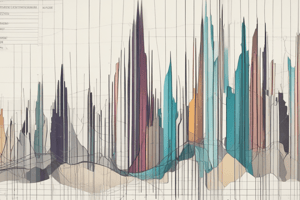Podcast
Questions and Answers
What is the primary role of domain experts in Data Science?
What is the primary role of domain experts in Data Science?
- To provide specialized knowledge in specific fields (correct)
- To design algorithms for predictive models
- To perform statistical analyses of data
- To develop programming skills for data processing
Which of the following techniques is NOT typically associated with Data Science?
Which of the following techniques is NOT typically associated with Data Science?
- Cluster analysis
- Quantum computing (correct)
- Machine learning
- Data mining
How does Data Science enhance decision-making in self-driving cars?
How does Data Science enhance decision-making in self-driving cars?
- By using human drivers for validation of automated decisions
- By storing data on driving behavior for future reference
- By collecting and analyzing real-time data from various sensors (correct)
- By relying solely on pre-programmed algorithms for navigation
What significant percentage of data is expected to be unstructured by 2025?
What significant percentage of data is expected to be unstructured by 2025?
Which of the following fields is NOT commonly involved in Data Science?
Which of the following fields is NOT commonly involved in Data Science?
What is an example of discrete data?
What is an example of discrete data?
Which statement characterizes continuous data?
Which statement characterizes continuous data?
What is NOT a benefit of having data?
What is NOT a benefit of having data?
What is meant by the term 'unstructured data'?
What is meant by the term 'unstructured data'?
Which component of data transformation refers to identifying patterns?
Which component of data transformation refers to identifying patterns?
Flashcards are hidden until you start studying
Study Notes
Types of Data
- Discrete Data: Values that are distinct and separate, such as the number of cars (e.g., Jatin has 2 cars) or players in a field (e.g., 13 players).
- Continuous Data: Values can fall within a range, such as weight (e.g., 37 kg) or body temperature (e.g., 101°F).
Data Transformation Pyramid
- Data: The raw, unfiltered state of information.
- Information: Identifies patterns within the data.
- Knowledge: Provides predictability based on the information.
- Wisdom: Represents the highest form of understanding derived from the knowledge.
Domains of Data
- Business: Includes sales, finance, marketing.
- Geographical: Involves climate, meteorological, and location data.
- Transport: Data from sensors, cameras, and navigational systems.
- Scientific: Covers biological, astrophysical, and medical data.
- Statistical: Various forms of statistical information.
Data Generation
- Magnitude of Data: 2.5 quintillion bytes generated daily.
- Sources of Data: Social media, business transactions, location-based data, sensors, digital media, and consumer behavior.
Benefits of Data
- Recommendations: Algorithms suggest movies, restaurants, or books.
- Classifications: Sorting emails based on type (important, social, promotions).
- Pattern Detection: Analyzing weather or financial market patterns.
- Forecasting: Predicting sales and customer retention.
- Recognition: Voice, facial, and text recognition capabilities.
- Anomaly Detection: Identifying fraud or diseases.
Data Trends
- Unstructured Data: By 2025, over 80% of data will be unstructured.
- Data Science: Combines programming, statistics, and domain expertise to derive insights from data.
Data Science Components
- Multidisciplinary: Involves statisticians, computer scientists, mathematicians, and domain experts across multiple fields.
- Techniques Used: Machine learning, cluster analysis, data mining, and visualization.
Practical Applications of Data Science
- Recommendation Systems: Analyze customer data for personalized suggestions.
- Decision-Making: Self-driving cars utilize data from sensors to make driving decisions.
- Predictive Analysis: Weather forecasting using various data collection methods to predict natural disasters.
Data Analysis Process
- Life Cycle: Comprises data requirement specifications, data collection, data processing, data cleaning, and data modeling.
- Data Cleaning: Addresses issues like typographical errors, missing values, and out-of-range values.
Categories of Data
- Structured Data: Fixed format stored in databases (e.g., enrollment records).
- Unstructured Data: Diverse formats without a fixed structure, challenging to process (e.g., text files, images).
- Semi-Structured Data: Mixture of structured and unstructured (e.g., XML, JSON).
Relationship of AI, ML, and DL
- Artificial Intelligence (AI): Encompasses algorithms simulating human intelligence.
- Machine Learning (ML): A subset of AI focused on learning from data.
- Deep Learning (DL): A further subset of ML that leverages neural networks for complex learning tasks.
Learning Algorithms
- Supervised Learning: Requires labeled data for training to recognize features and accurately classify inputs.
- Unsupervised Learning: Does not require labeled data; it identifies hidden patterns and insights independently.
Netflix Case Study: Recommendation System
- Function: Analyzes user preferences to suggest movies similar to past selections.
- Types of Systems:
- Content-Based: Recommends similar content based on user history and characteristics (e.g., genre).
- Collaborative Filtering: Provides recommendations based on the preferences of similar users to enhance viewing experience.
Studying That Suits You
Use AI to generate personalized quizzes and flashcards to suit your learning preferences.




